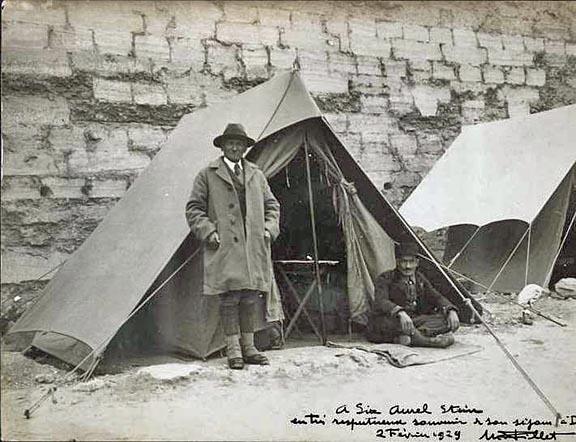
Aurel Stein at Dura-Europos, 1929. The British Library, Photo 392/42*
Over the winter of 1928-9, the city of Dura-Europos on the Euphrates was being excavated by a team led by Maurice Pillet (1881-1964), which included a Yale academic, Clark Hopkins (1895-1976) and his wife, Susan M. Hopkins (1900-?), the last responsible for registering the finds. They camped at the local village, Salihyeh, while a house was built to house the archaeological mission.
Susan Hopkins sent regular letters to her family in the US giving valuable insight into life in the camp.[1] Writing to her family on 26 January 1929 she reported that: ‘We have in camp a very distinguished guest, an Englishman Sir Orel [sic] Stein who has traveled and dug all over the East in Turkestan, Afghanistan, Persia and forty years in India. He is a funny little fellow and terribly slow but nice, and he does know heaps. He’s got his own tent, but he eats with us. He leaves tomorrow by camel for Palmyra.’
Stein was by this time, at the age of 67, on his retirement tour of the west Asian parts of the Silk Roads.[2] He had set out in November the previous year, heading to Karachi, Basra and to Baghdad. This he made his base for visiting Samarra and Ctesiphon, before travelling by car along the Euphrates to track the limes — Roman-period defensive walls. He moved from one archaeological site to another — Ur, Lagash, Wraka, Samarra — before taking to an RAF plane at Mosul to see other, more distant, sites. He arrived at Dura-Europos in January. His intention was to join camel troops to go to Palmyra on further surveys of the limes. However, as Susan Hopkin’s subsequent letter to her sister on 31 January shows, he remained longer than expected at Dura-Europos.
‘We still have our distinguished visitor, Sir Aurel Stein, with us and shall have for some time. He is a little, ordinary-looking Englishman, who has been archeologizing in this part of the world most of this life — for more than 40 years. Apparently he is a person of great consequence because the Syrian government was warned in advance of his coming, and everyone was prepared to be hospitable.
‘We, however, weren’t quite prepared for his pitching his tent in our backyard and staying. He is waiting now for a platoon of Méhariste, the camel troops, who are to go with him to Palmrya at which place he hopes to find an important ancient route. He is an old friend of Clark’s father [3] and the author of several books, one of which — Clark says its a beautiful book — is called Innermost Asia. I think you might like to look at it.’
As the editors of Susan Hopkin’s letters go on to explain, during his time there Clark Hopkins and Maurice Pillet took Stein in their car to make a desert reconnaissance in search of ancient routes. Clark later writes to his father about the journey back:
‘Stein got lost. He kept giving the chauffeur the wrong directions as he led us back to Dura in the afternoon. He sat in the back seat with his compass and would shout to the driver “a little right” and “a little left” and this way and that every few yards.’ Looking through his field glasses he then identified Salihyeh but, when they got closer it turned out to be a flock of sheep. Next he drove them to a cliff face, also wrongly identified as the village. Finally they made their way back by asking directions of some shepherds. Clark is amused to note that Susan had remarked before the trip that it ‘would be most useful to observe his methods.'[4] But perhaps the speed of travelling by car rather than on horseback upset Stein’s normally reliable natural gyroscope. Pillet inscribed the photograph of Stein in front of his tent [above] as a remembrance of his stay.
Stein left in early February. He was to return to the Euphrates in 1938 where, on his way to Palmyra, he discovered a ‘well-preserved castellum with a massive barrage, a fine specimen of Roman engineering'[5] a discovery reported in an article in The Times on 1 June 1939.[6] He then took again to the air, thanks to the RAF and the Iraq Petroleum Company, finding more signs of the Roman routes.
* This is one of two loose prints with covering letter from Maurice Pillet, dated Paris 27 June 1929. In this letter Pillet asks Stein to accept the photographs as a souvenir of his time at Dura-Europos and thanks him for sharing his knowledge of the history and archaeology of Asia during his short visit: ‘It goes without saying that I would be very happy to welcome you again to Salhiyah for as long as you wished. Our house is completed and is comfortable, but our tents remain, if you prefer.’
Thanks to John Falconer for this information.
___
Notes
[1] Susan M. Hopkins, Bernard Goldman, Norma Goldman. My Dura-Europos: The Letters of Susan M. Hopkins, 1927-1935. Wayne State University Press 2011. Her husand writes about Stein’s visit in his account of the excavations, Clark Hopkins (ed. Bernard Goldman), The Discovery of Dura-Europos. New Haven and London: Yale University Press, 1979: pp. 59-60.
[2] Jeanette Mirsky. Sir Aurel Stein: Archaeological Explorer. Chicago and London: The University of Chicago Press 1977: 459.
[3] Edward Washburn Hopkins (1857–1932).
[4] Susan M. Hopkins, Bernard Goldman, Norma Goldman. My Dura-Europos: The Letters of Susan M. Hopkins, 1927-1935. Wayne State University Press 2011: 149.
[5] Jeanette Mirsky. Sir Aurel Stein: Archaeological Explorer. Chicago and London: The University of Chicago Press 1977: 515.
[6] Helen Wang. Sir Aurel Stein in The Times. London: Saffron Books, 2002: 127.